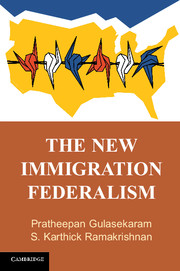Book contents
- Frontmatter
- Dedication
- Contents
- List of Figures and Tables
- Acknowledgments
- 1 Introduction
- 2 Setting the Stage for the New Immigration Federalism
- 3 Rise of Restrictive Legislation and Demographic Arguments of “Vital Necessity”
- 4 A Political Theory of Immigration Federalism: The Polarized Change Model and Restrictive Issue Entrepreneurs
- 5 A Shifting Tide in 2012: Pro-Integration Activists Gain the Upper Hand
- 6 Implications for Legal Theory on Federalism and Immigration Law
- 7 Immigration Federalism Is Here To Stay
- Appendix A Statistical Analysis of Restrictive Local Ordinances
- Appendix B Statistical Analysis of Restrictive State Laws
- Appendix C Statistical Analysis of State Immigrant Integration Laws
- Notes
- Index
Appendix A - Statistical Analysis of Restrictive Local Ordinances
Published online by Cambridge University Press: 05 November 2015
- Frontmatter
- Dedication
- Contents
- List of Figures and Tables
- Acknowledgments
- 1 Introduction
- 2 Setting the Stage for the New Immigration Federalism
- 3 Rise of Restrictive Legislation and Demographic Arguments of “Vital Necessity”
- 4 A Political Theory of Immigration Federalism: The Polarized Change Model and Restrictive Issue Entrepreneurs
- 5 A Shifting Tide in 2012: Pro-Integration Activists Gain the Upper Hand
- 6 Implications for Legal Theory on Federalism and Immigration Law
- 7 Immigration Federalism Is Here To Stay
- Appendix A Statistical Analysis of Restrictive Local Ordinances
- Appendix B Statistical Analysis of Restrictive State Laws
- Appendix C Statistical Analysis of State Immigrant Integration Laws
- Notes
- Index
Summary
We started with a baseline of municipalities (defined as “places” in most states, but also including “county subdivisions” in others). Next, we obtained lists of municipalities that have proposed restrictive ordinances and regulations from various sources, including the American Civil Liberties Union, Latino Justice PRLDEF, the Fair Immigration Reform Movement, the National Immigration Law Center, and the Migration Policy Institute. We then validated these lists by making phone calls to jurisdictions noted as considering or passing ordinances, as well as by monitoring news stories on local ordinances through December 2011. Still, the data on municipal ordinances became less reliable after 2007, due to a sharp decline in newspaper reports of new municipal ordinances and no further tracking of municipal legislation by national advocacy groups. We merged information on the proposal and passage of ordinances with demographic data from the 2000 Census and the 2005–2009 American Community Survey. Our municipal analysis is presented in Table A.1.
Multivariate Regression Analyses
Model I is a standard logistic regression, which is appropriate for regressions where outcomes take on binary values of 1 and 0. Logistic regressions also have the benefit of allowing coefficients to be converted easily to odds ratios. Model II is a rare-events logistic regression, using the Relogit statistical software package from http://gking.harvard.edu/relogit. The model weights the sample such that the weighted ratio of 0s and 1s in the sample matches that of the population, a process designed to correct for selection on the dependent variable.
- Type
- Chapter
- Information
- The New Immigration Federalism , pp. 207 - 208Publisher: Cambridge University PressPrint publication year: 2015



